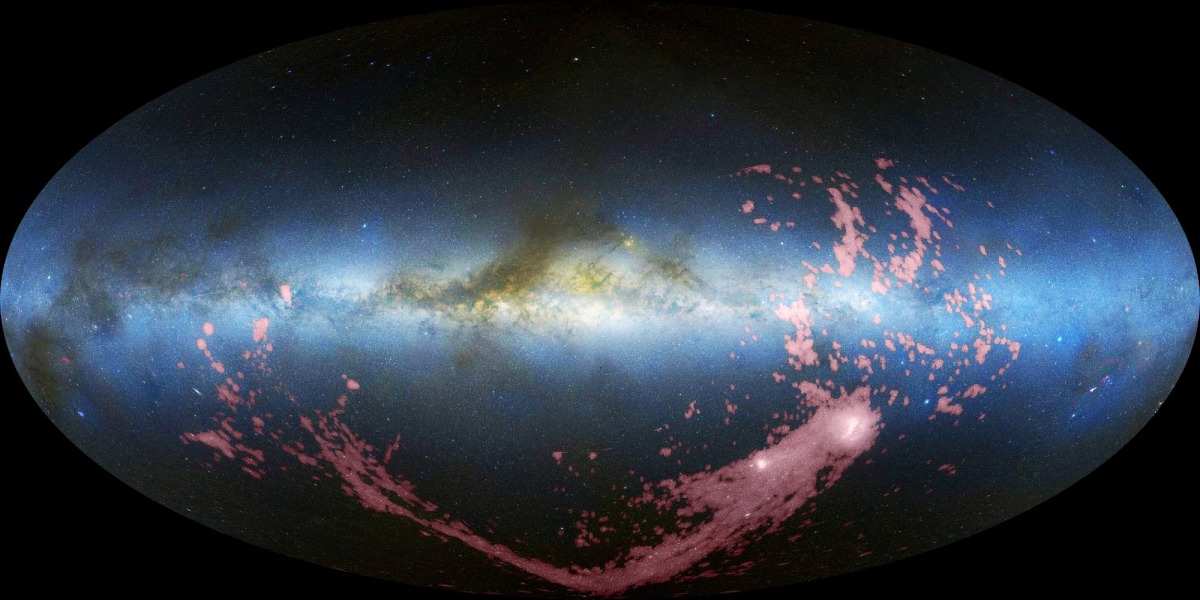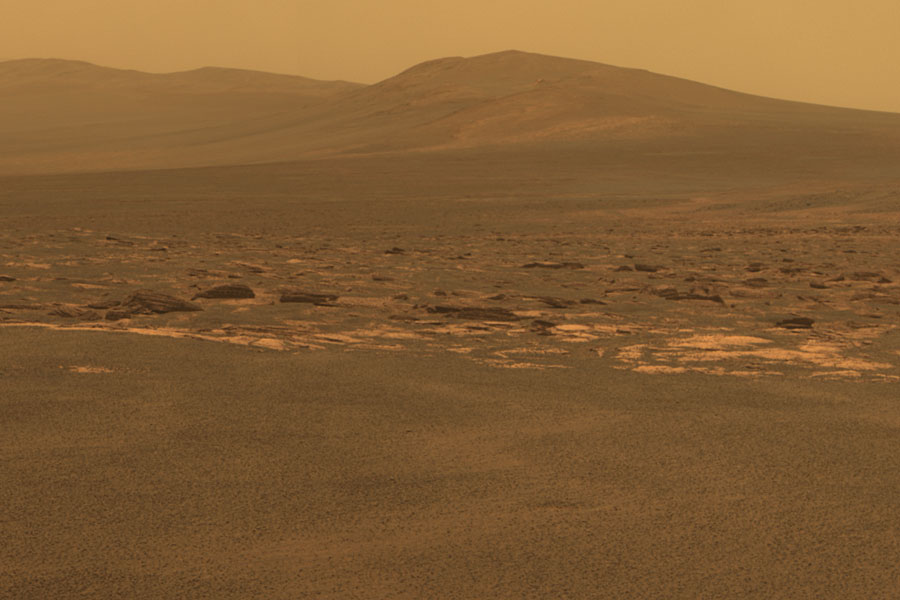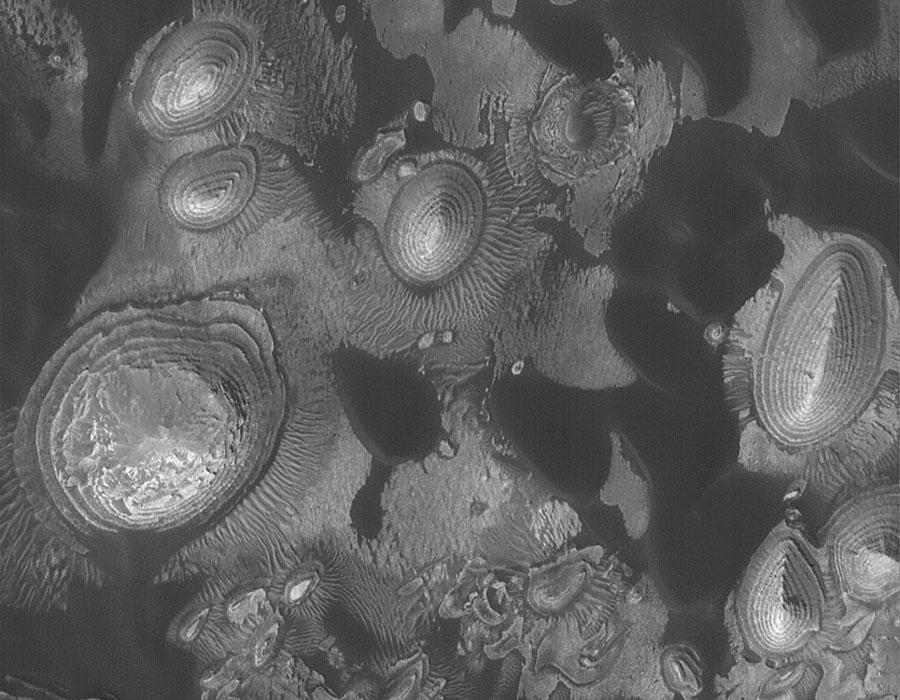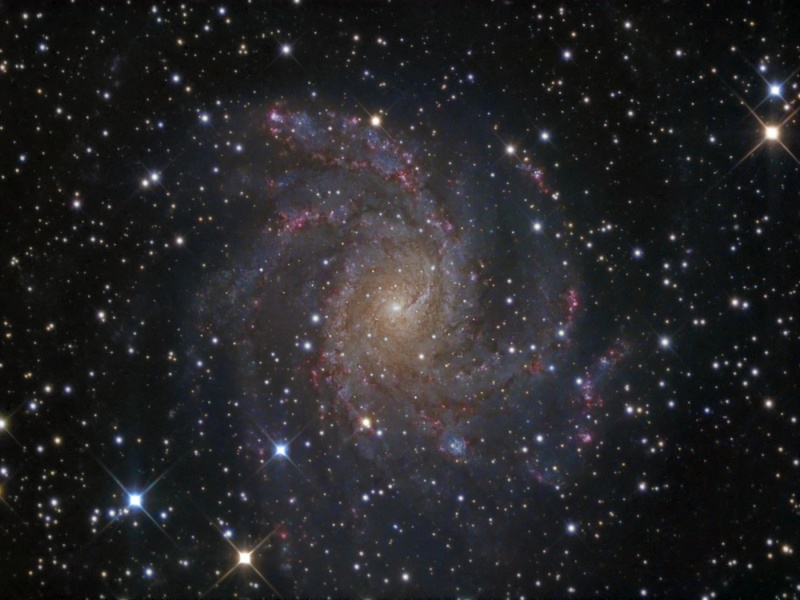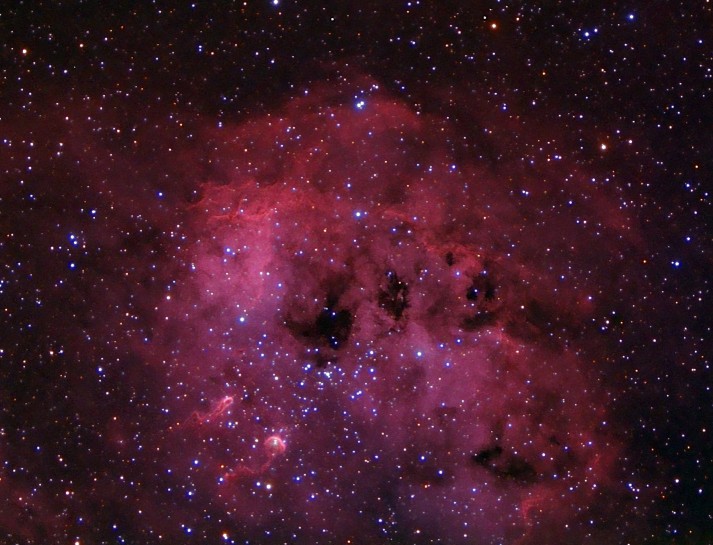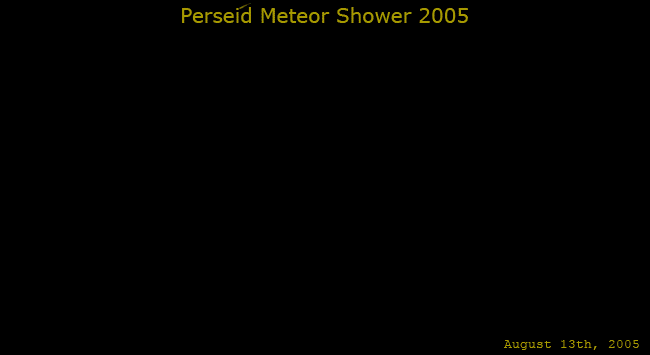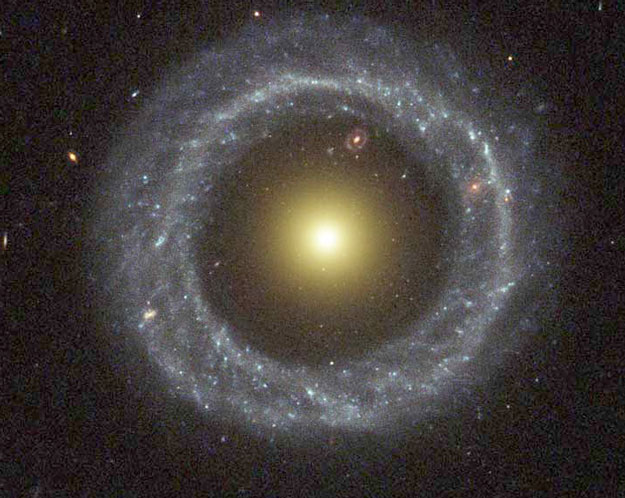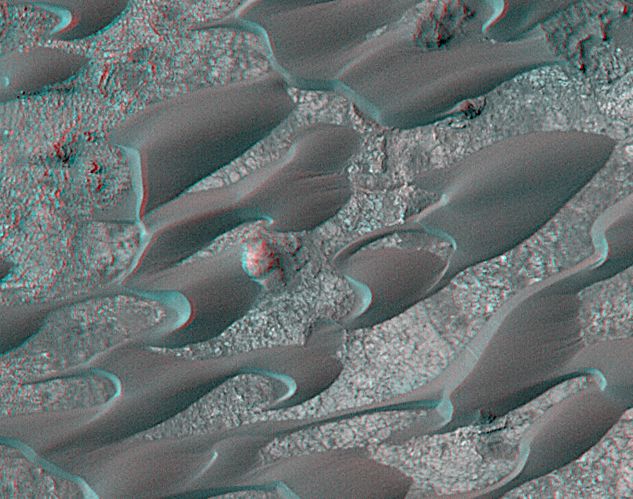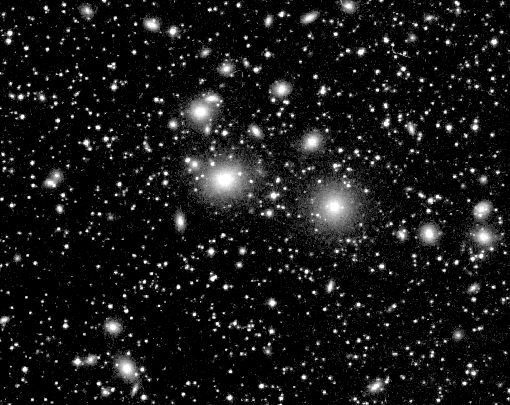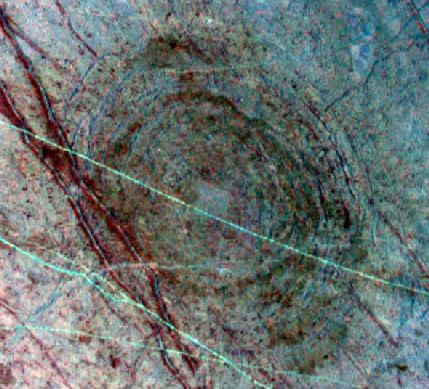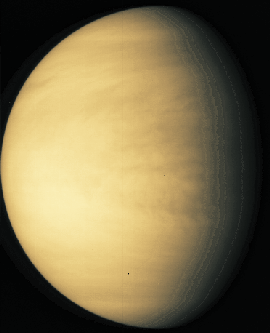| << Previous | Index | Next >> |
2015 This dramatic outburst from the nucleus of Comet 67P/Churyumov-Gerasimenko occured on August 12, just hours before perihelion, its closest approach to the Sun. Completing an orbit of the Sun once every 6.45 years, perihelion distance for this periodic comet is about 1.3 astronomical units (AU), still outside the orbit of planet Earth (at 1 AU). The stark image of the 4 kilometer wide, double-lobed nucleus in bright sunlight and dark shadows was taken by the Rosetta spacecraft's science camera about 325 kilometers away. Too close to see the comet's growing tail, Rosetta maintains its ringside seat to watch the nucleus warm and become more active in coming weeks, as primordial ices sublimating from the surface produce jets of gas and dust. Of course, dust from the nucleus of periodic comet Swift-Tuttle, whose last perihelion passage was in 1992 at a distance of 0.96 AU, fell to Earth just this week.
2014 Bright moonlight from a Full Moon near perigee illuminates the night and casts shadows in this skyscape from central Iran. Taken on August 12, near the peak of the annual Perseid meteor shower the exposure also captures a bright and colorful perseid streak above the shady tree in the foreground. This year the super moonlight interfered with meteor watching into the early morning hours, overwhelming the trails from many fainter perseids in the shower. Brighter perseids like this one were still visible though, their trails pointing back to the heroic constellation Perseus outlined at the right. Swept up as planet Earth orbits through dust left behind from periodic comet Swift-Tuttle, the cosmic grains that produce perseid meteors enter the atmosphere at nearly 60 kilometers per second, heated to incandesence and vaporized at altitudes of about 100 kilometers. Next year, Perseid meteors will flash through dark skies under a New Moon.
2013
2012 If you could stand on Mars, what would you see? The above image is a digitally re-colored approximation of what you might see if the above Martian landscape had occurred on Earth. Images from Mars false-colored in this way are called white balanced and useful for planetary scientists to identify rocks and landforms similar to Earth. The image is a high resolution version of a distant wall of Gale Crater captured by the Curiosity rover that landed on Mars last week. A corresponding true color image exists showing how this scene actually appears on Mars. The robotic Curiosity rover continues to check itself over and accept new programming from Earth before it begins to roll across Mars and explore a landscape that has the appearance of being an unusually layered dried river bed.
2011 What can the present-day terrain in and around large Endeavour crater tell us about ancient Mars? Starting three years ago, NASA sent a coffee-table sized robot named Opportunity on a mission rolling across the red planet's Meridiani Planum to find out. Last week, it finally arrived. Expansive Endeavour crater stretches 22 kilometers from rim to rim, making it the largest crater ever visited by a Mars Exploration Rover (MER). It is hypothesized that the impact that created the crater exposed ancient rock that possibly formed under wet conditions, and if so, this rock may yield unique clues to the watery past of Mars. Pictured above, the west rim of Endeavour looms just ahead of the Opportunity rover. Opportunity may well spend the rest of its operational life exploring Endeavour, taking pictures, spinning its wheels, and boring into intriguing rocks.
2010 Why are some hills on Mars so layered? The answer is still under investigation. Clearly, dark windblown sand surrounds outcropping of light sedimentary rock across the floor of crater Arabia Terra. The light rock clearly appears structured into many layers, the lowest of which is likely very old. Although the dark sand forms dunes, rippled dunes of lighter colored sand are easier to see surrounding the stepped mesas. Blown sand possibly itself eroded once-larger mesas into the layered hills. Most of the layered shelves are wide enough to drive a truck around. The above image, showing an area about 3 kilometers across, was taken in 2003 October by the now defunct Mars Global Surveyor spacecraft orbiting Mars.
2009 Dark skies are favored for viewing meteor showers. But the annual Perseid Meteor Shower still entertained skygazers around the world this week even though the Moon brightened the night. At its last quarter phase and rising around midnight on August 13, after the shower's anticipated peak, the Moon is seen here above rock formations in the Alborz Mountains near Firouzkooh, Iran. With a dramatic desert landscape in the foreground, a Perseid meteor is streaking through the moonlit sky between the overexposed Moon and bright planet Jupiter at the upper right. A regular celestial event in the northern hemisphere, the Perseid Meteor Shower is caused by planet Earth's yearly passage through the dust stream cast off by comet Swift-Tuttle.
2008 From our vantage point in the Milky Way Galaxy, we see NGC 6946 face-on. The big, beautiful spiral galaxy is located just 10 million light-years away, behind a veil of foreground dust and stars in the high and far-off constellation of Cepheus. From the core outward, the galaxy's colors change from the yellowish light of old stars in the center to young blue star clusters and reddish star forming regions along the loose, fragmented spiral arms. NGC 6946 is also bright in infrared light and rich in gas and dust, exhibiting a high star birth and death rate. In fact, since the early 20th century at least nine supernovae, the death explosions of massive stars, were discovered in NGC 6946. In this deep color composite image, a small barred structure is just visible at the galaxy's core. Nearly 40,000 light-years across, NGC 6946 is also known as the Fireworks Galaxy.
2007 What are they? Five streaks near the bottom of the above image taken near Ankara, Turkey on Sunday would be identified at first glance as meteors from the Perseids meteor shower peaking just that night. Unexpectedly, however, these streaks do not point back to the Perseids radiant in Perseus. Their origin is therefore somewhat unclear. The above image was captured over the time span of 40 minutes. Other visible celestial icons include the constellation Orion and the Pleiades star cluster. One hypothesis is that the streaks are part of a microburst from a much less active meteor shower known as the Alpha Ursae Majorids. Another possibility is that they are parts of a satellite that broke up as it re-entered the Earth's atmosphere. A discussion of these possibilities can be found here. This year's Perseids meteor shower was a good one, as it was particularly active and corresponded with the dark skies that come with a new moon.
2006 A faint, dusty rose of the northern sky, emission nebula IC 410 lies about 12,000 light-years away in the constellation Auriga. The cloud of glowing hydrogen gas is over 100 light-years across, sculpted by stellar winds and radiation from embedded open star cluster NGC 1893. Formed in the interstellar cloud a mere 4 million years ago, bright cluster stars are seen just below the prominent dark dust cloud near picture center. Notable near the 7 o'clock position in this wide, detailed view are two relatively dense streamers of material trailing away from the nebula's central regions. Potentially sites of ongoing star formation, these cosmic tadpole shapes are about 10 light-years long.
2005 Where will the next Perseid meteor appear? Sky enthusiasts who trekked outside for the Perseid meteor shower that peaked over the past few days typically had this question on their mind. The above movie, where the time-line has been digitally altered, captures part of that very mystery. Eight meteors from the night of August 12 and the morning of August 13 have been identified in the movie so far, seven of which are Perseids. Can you identify the non-Perseid meteor? Since all Perseid meteors appear to come from the constellation of Perseus, the non-Perseid meteor is the one that streaks in a different direction. Early reports are that this year's Perseids were unfortunately a bit disappointing. The above digital mosaic was taken from Alsace, France, with the photogenic band of our Milky Way Galaxy far in the background.
2004 Is this one galaxy or two? This question came to light in 1950 when astronomer Art Hoag chanced upon this unusual extragalactic object. On the outside is a ring dominated by bright blue stars, while near the center lies a ball of much redder stars that are likely much older. Between the two is a gap that appears almost completely dark. How Hoag's Object formed remains unknown, although similar objects have now been identified and collectively labeled as a form of ring galaxy. Genesis hypotheses include a galaxy collision billions of years ago and perturbative gravitational interactions involving an unusually shaped core. The above photo taken by the Hubble Space Telescope in July 2001 reveals unprecedented details of Hoag's Object and may yield a better understanding. Hoag's Object spans about 100,000 light years and lies about 600 million light years away toward the constellation of Serpens. Coincidentally, visible in the gap (at about one o'clock) is yet another ring galaxy that likely lies far in the distance.
2003 High-resolution imaging of an area in the Schiaparelli Basin of Mars on June 3 by the MGS Mars Orbiter camera produced this stunning example of layered formations within an old impact crater. On planet Earth, such structures would be seen in sedimentary rock -- material deposited at the bottom of ancient lakes or oceans and then subsequently weathered away to reveal the layers. With the Sun shining from the left, the central layer appears to stand above the others within the 2.3 kilometer wide crater. The crater could well have been filled with water in Mars' distant past, perhaps resting at the bottom of a lake filling the Schiaparelli impact basin. Still, such layers might also have been formed by material settling out of the windy martian atmosphere. As satellites continue to examine the martian surface from orbit, NASA's Spirit and Opportunity spacecraft will attempt to land on on Mars early next year to further explore the tantalizing history of water on the Red Planet.
2002 Skygazers report that the annual Perseid meteor shower went pretty much as predicted, producing a meteor every few minutes during the dark early morning hours of August 12 and 13. And as the constellation Perseus rose above the horizon on the night of August 11, astrophotographer Wade Clark was anticipating recording images of the flashing meteor trails from the Mt. Baker Ski Area in northwest Washington, USA. But Clark was also treated to a colorful display of northern lights. As a result, the stars of Perseus are arrayed near the center of his well composed skyscape along with trails of Perseid meteors all viewed through the auroral glow. The alluring scene might look familiar to watchers of bygone Perseids. For many, views of the meteor shower in 2000 also coincided with auroral displays, courtesy of the active Sun.
2001 Get out your red/blue glasses and treat yourself to this dramatic 3-D view of sand dunes on Mars! The field of undulating dunes is found in Nili Patera, a volcanic depression in central Syrtis Major, the most prominent dark feature on the Red Planet. Two different images from the orbiting Mars Global Surveyor spacecraft were combined to make this stereo picture, one taken in March 1999 and the other recorded in April 2001. Sculpted by winds like the sand dunes of Earth, these particular Martian dunes show no change in shape over the time separating the two images, a period equivalent to about one Martian year. This cropped version of the 3-D picture spans an area around 2 kilometers across. Walking, you might cover that distance in about 20 minutes.
2000 It is still not known why the Sun's light is missing some colors. Shown above are all the visible colors of the Sun, produced by passing the Sun's light through a prism-like device. The above spectrum was created at the McMath-Pierce Solar Observatory and shows, first off, that although our yellow-appearing Sun emits light of nearly every color, it does indeed appear brightest in yellow-green light. The dark patches in the above spectrum arise from gas at or above the Sun's surface absorbing sunlight emitted below. Since different types of gas absorb different colors of light, it is possible to determine what gasses compose the Sun. Helium, for example, was first discovered in 1870 on a solar spectrum and only later found here on Earth. Today, the majority of spectral absorption lines have been identified - but not all.
1999 What's going on in the center of this spiral galaxy? Named the Sombrero Galaxy for its hat-like resemblance, M104 features a prominent dust lane and a bright halo of stars and globular clusters. Something truly energetic is going on in the Sombrero's center, as it not only appears bright in visible light, but glows prodigiously in X-ray light as well. This X-ray emission coupled with unusually high central stellar speeds cause many astronomers to speculate that a black hole lies at the Sombrero's center - a black hole possibly a billion times the mass of our Sun.
1998 Here is one of the largest objects that anyone will ever see on the sky. Each of the fuzzy blobs in the above picture is a galaxy, together making up the Perseus Cluster, one of the closest clusters of galaxies. We view the cluster through the foreground of faint stars in our own Milky Way Galaxy. It takes light roughly 300 million years to get here from this region of the Universe, so we see this cluster as it existed before the age of the dinosaurs. Also known as Abell 426, the center of the Perseus Cluster is a prodigious source of X-ray radiation, and so helps astronomers explore how clusters formed and how gas and dark matter interact. The Perseus Cluster of Galaxies is part of the Pisces-Perseus supercluster of galaxies, which spans over 15 degrees and contains over 1000 galaxies.
1997 This bull's-eye pattern marks the impact of a mountain-sized comet or asteroid on the icy surface of Jupiter's moon Europa. Recorded by the Galileo spacecraft in April of this year, the composite false color image clearly reveals the telltale concentric fractures which cover about 86 miles - roughly equivalent to the Island of Hawaii. The fat reddish and finer blue-green lines overlay the impact fractures and must therefore be younger surface features formed after the impact. The dark red color may be the result of a a relatively dirty water-ice mixture. The possibility of liquid water below the ice has fueled speculation that life may exist on this large and distant moon.
1996 Io's surface is active. Geyser-like eruptions from volcanoes on this Jovian moon were seen by both Voyager spacecraft in 1979 and were also spotted this year in late June by Galileo's camera from a distance of about 600,000 miles. The blue plume seen at the moon's edge (magnified in the inset) arises from Ra Patera, a large shield volcano, and extends about 60 miles above the surface. The blue color is attributed to condensing and freezing sulfur dioxide gas. Galileo images have also revealed that the plume glows in the dark - perhaps due to fluorescence of excited sulfur and oxygen ions. Io's surface is cold, its temperature averages about -230 degrees Fahrenheit, so why is it so active? The most likely cause is the gravitational tug of war over Io between Jupiter and the other Galilean moons which perturbs Io's orbit. The orbital changes would result in tidal force variations heating Io's interior and and generating the sulfurous volcanic activity.
1995 This picture in visible light was taken by the Galileo spacecraft. Venus is very similar to Earth in size and mass - and so is sometimes referred to as Earth's sister planet - but Venus has a quite different climate. Venus' thick clouds and closeness to the Sun (only Mercury is closer) make it the hottest planet - much hotter than the Earth. Humans could not survive there, and no life of any sort has ever been found. When Venus is visible it is usually the brightest object in the sky after the Sun and the Moon. More than 20 spacecraft have visited Venus including Venera 9, which landed on the surface, and Magellan, which used radar to peer through the clouds and make a map of the surface. There are still many things about Venus's unusual atmosphere that astronomers don't understand.
| << Previous | Index | Next >> |


